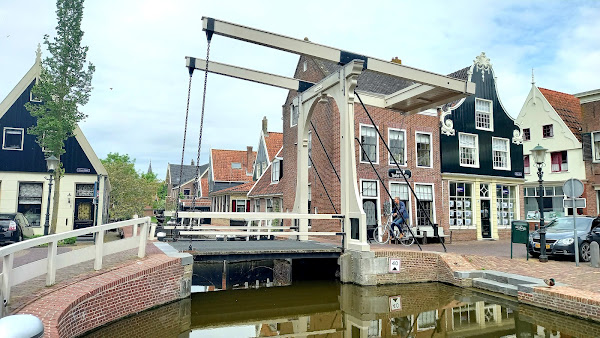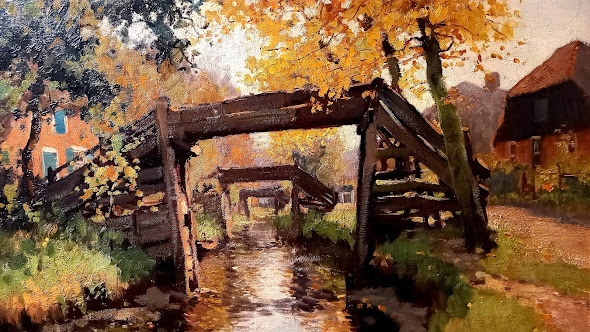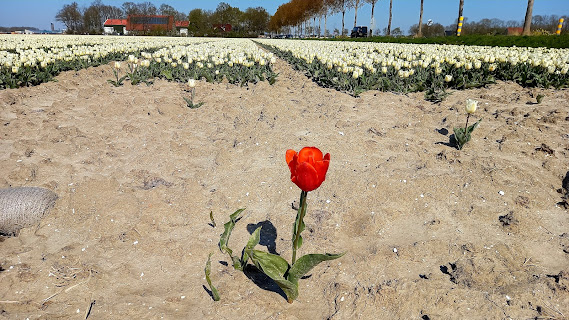This is a bit of a spin-off, as we only did a day trip, but thought we would include it here anyways, as it was really nice!
We had been wanting to go to Bergen with the bike for a while, and saw in our trusty book listing the most beautiful Dutch towns that De Rijp was one of them. As it was sort of close-by, we decided to make a day of it.
We took the train to Uitgeest, as we saw that this would allow up to go around a lake.
The ride was nice but the weather was not great, luckily without too much wind.
**********
We arrived at De Rijp around 11am, and went straight for the museum. It was quite small, and almost all in Dutch, and spoke about the city's past being an island on the middle of swamps, the eternal fight against the rising water and sinking ground, and their golden age as herring merchants.
The area was then called Schermereylandt (Schermer Island), and was surrounded by lakes, which have since then been reclaimed.
Since the land kept sinking and digs always had to be rebuilt, they could not do much more than use it as pasture for cows, so the people were quite poor. They then gained success by becoming a popular port, and in the 17th century had a fleet of ships used for herring fishing. The main city for herring was Enkhuizen, and De Rijp became the second. This is why it has 2 herrings on its coat of arms, when Enkhuizen has 3.
When the business of fishing herring declined (mainly due to the competition of other cities, and the lack of herring leaving to inhabit other areas), whale fishing took up. This lasted until whales became too scarce to make this a viable profession.
Hemp processing was also one of the sources of prosperity, as very high quality ropes and fishing nets were created.
One of the famous De Rijp citizens was a sailor who was shipwrecked and ended up becoming the first European in Korea and an advisor to the Korean king of the Joseon Dynasty.
De Rijp fell into poverty after the third of it's 3 fires. In the first one in 1654, most of the town burned due to a hemp mill overheating (due to a storm spinning the blades too fast), creating a fire which spread to all the surrounding houses and hemp storage. Only the town hall from 1630 was spared. The town was rebuilt, but never to its original splendor. After the third fire, a rule was created for houses to be built in brick at least up to the first floor.
After the museum we had a little walk. The village is beautiful, with houses made of brick or wood. We found a nice place for our picnic as again, we had made one of our lovely sandwiches, this time with grilled courgette :)
**********
We then got back on the bikes and headed for Alkmaar and Bergen. On the way we passed the little village of Driehuizen, which means "three houses". It's very small, very pretty, and very quiet, with a preschool, a church and a café.
**********
We passed straight through Alkmaar to reach Bergen. We had a much needed coffee at the nicest café Het Huis met de Pilaren (meaning "the house with the pillars"), and before falling asleep in our chairs we moved on to the little museum, located in the oldest house of the village (from 1655).
This museum is nice but not too interesting to be honest, showing furniture, clothing and artifacts from the past, as most small museums do. Upstairs is information about the Bergen railroad that would bring people back and forth to the beach at Bergen aan Zee, and give accounts of the time in the war.
During the Napoleonic wars, in 1799, the British and Russian forces decide to open a new front while most of the forces were fighting in Italy, and they decide to land in North Holland. The Russians occupied Bergen and the plan was for the British to come from the other side to destroy the French Batavians coming to free Bergen. However the British arrived an hour late due to a rookie mistake: the commanders had not synchronized their watches. The battle was lost.
Bergen is a very beautiful little town, populated mostly but Germans who own holiday homes here. All houses for sale are over 1 million, but it's most likely worth it, as everything is perfect here; the houses and gardens are beautiful, the streets are lined with big trees, everyone is friendly, and there are many little shops selling overpriced things. It really feels like a beach town.
We went for a walk to pick which house we will each buy in the future, and then stopped in the park to eat the nicest little cakes "Ruinestenen" from the famous Patisserie Roos.
**********
We headed back to Alkmaar to catch the train. We had planned on visiting Alkmaar but by then we were too tired, and decided this would be a visit for another day.
-- Our total bike riding distance was 48km --


































Comments
Post a Comment